Abstract
This leaflet has three purposes. It first defines digital technologies from the perspective of communication and coding. Then it describes the key components of a digital imaging system and the most important steps in the digital imaging process. Finally, it asks some big questions that ought to be considered as libraries and archives move from experimenting with the technology to using it as a tool for transforming the way they do business.
Introduction
We are living in a digital world. The evidence is everywhere. Keyboards outnumber office workers. Everybody has a web page. Nobody carries cash. We are hearing words like "bitslag," "jitterati," "NIMQ," and "CGIJoe" in everyday conversation. Billionaire technologists seem to own all the digital copies of all the art that matters. There seems to be a growing concern in libraries and archives that if we are not going digital, being digital, or dreaming digital, then we are relegating ourselves to the great museum of paper.1
And yet, it may be that our biggest challenge may not be embracing digital technology but rather building a common language to describe the transformations that are having such a phenomenal impact on our everyday lives. A shared vocabulary is the key element in the development of a community of practice and a shared vision of the future among those of us who have responsibility to shepherd the nation's cultural resources. Jim Taylor and Watts Wacker note that "Looking backward, the true legacy of Naisbitt's Megatrends or Toffler's Third Wave may turn out to be not the worldviews but the words."2 Nowhere have the words mattered more than in our view of the place of preservation in the digital world in which we live.
Fundamental Digital Concepts
At their most fundamental level, digital technologies are an extension of the long history of the way we communicate with each other. The desire to communicate provides the motive and the ultimate rationale for the development of technologies of all sorts. Today's digital world is concerned with creating, sharing, and using information in digital form. Digital information is data that are structured and manipulated, stored and networked, subsidized and sold.
Information takes many forms. One way to think about these forms is to distinguish between symbolic information and coded information. Let us illustrate this by looking at the many ways that the most common letter in the roman alphabet — the "E" — can be represented, beginning with the early symbols of the printed alphabet.
A History Lesson
The period from the time Gutenberg invented in the middle of the fifteenth century through the year 1500 is referred to generally as the period of incunabula. During this time printers and book designers went to great lengths to make their products—type faces, format, and layout—look and function much like the manuscript books of the preceding centuries. Only when a theory of the alphabet and a theory of the book emerged around the time of Geofroy Tory's classic text on the structure of the roman alphabet were book designers able to begin taking full advantage of Gutenberg's technological innovation.3
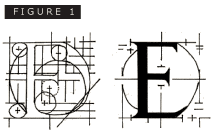 Figure 1 is an illustration of the capital letter "E" from Tory's Champ Fleury of 1529, which sought to develop a theory of the alphabet around the proportions of the human body and the basic principles of Euclid. Here the letter "E" is a pattern of ink on paper.4
Figure 1 is an illustration of the capital letter "E" from Tory's Champ Fleury of 1529, which sought to develop a theory of the alphabet around the proportions of the human body and the basic principles of Euclid. Here the letter "E" is a pattern of ink on paper.4
The world defined by strings of 1's and 0's has existed for a long time. The idea of the digital computer originated over 300 years ago in the fertile mind of a German mathematician, Gottfried Wilhelm von Leibnitz. In 1679, Leibnitz imagined a device in which binary numbers were represented by spherical pellets, circulating within a kind of pinball machine controlled by a rudimentary form of punched cards. He described a comprehensive numerical system in which all calculation can be expressed in combinations of 1 and 0—the identical approach that all digital technologies use today.5
We are living in an era of digital incunabula — a period marked by furtive efforts to make our digital products look and behave as their analog relatives do. Only when we have developed a theory of digital representation of information will we begin to take full advantage of Leibnitz's mathematical innovation. That theory is emerging today.6
Figure 2 is another symbolic pattern — Braille. Here the letter "e" is represented by large and small raised dots in a predictable grid. Note, too, that the same pattern can mean either the letter "E" or the number "5" depending upon the context in which the pattern is located. Context is another idea that is fundamental to the representation of information in digital form. With Braille, if you know the context and understand the pattern, communication is fast and efficient.
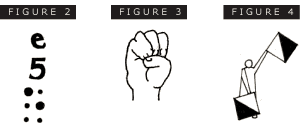
American Sign Language is symbol as signal. It is a language in which the form and motion of the hands combine to convey meaning. Form without motion is only half of the process. Communication depends upon a shared understanding of the meaning of both components of the language. Figure 3 is a static representation of the letter "E."
With semaphore, however, the pattern of motion is the symbol. The transformation from one formation of flags and arms to another establishes the communication link. Figure 4 is yet another static representation of the letter "E." Emerging theories of digital communication have yet to account fully for the multiple senses that we routinely use to communicate directly—the subtleties of body language, gesture, and inflection. As sophisticated as digital communication has become, its dependence on machines is seriously limiting.
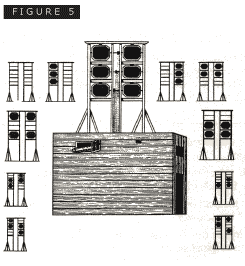 Some of the earliest modern forms of direct communication over long distances, however, have been digital in character. Figure 5 is an illustration of Lord George Murray's Visual Telegraph that operated for a time from London to Deal beginning in 1794.7 The system consisted of raised platforms placed horizon to horizon. On each platform a large board had six large circular holes that could be closed by wooden shutters — strikingly familiar to the patterns of Braille — manipulated by a trained operator. Reports indicate that a message could reach along the chain of fifteen stations in a few minutes. But just think about the administrative overhead!
Some of the earliest modern forms of direct communication over long distances, however, have been digital in character. Figure 5 is an illustration of Lord George Murray's Visual Telegraph that operated for a time from London to Deal beginning in 1794.7 The system consisted of raised platforms placed horizon to horizon. On each platform a large board had six large circular holes that could be closed by wooden shutters — strikingly familiar to the patterns of Braille — manipulated by a trained operator. Reports indicate that a message could reach along the chain of fifteen stations in a few minutes. But just think about the administrative overhead!
The route from the Visual Telegraph to modern digital communication is marked by successive transformations from symbol to code. Samuel F.B. Morse invented his digital code of dots and dashes as the language of his telegraph. The origins of radio — or wireless telegraphy — lie in the desire to extend the digital communication of Morse where wires could not reach. An early application of the analog technology of continuous waves was the transmittal of Morse's dots and dashes to ships at sea. The modern coding of the letter "E" as the ASCII code 01100101 owes its lineage to the theories of Leibnitz and the practical technology of Samuel Morse rather than to the technology of radio and television.
Code as Numbers — Some Building Blocks
A digital system uses numbers to represent a concrete object or an abstract idea. Digitization is the process of transforming the object or idea into a numerical code. The baseline of digital technology is a coding system with only two numbers — 1 and 0 — hence the term binary. Each numerical place in the system is a bit. In the digital world bits are things; they take up space; they take time to move from one place to another. A collection of bits can be described and counted, much like anything.8 The most common way to count the bits in a system is by "byte" or eight bits, even though computer technology abandoned the byte as a discrete object decades ago.
- Digital: using numbers to represent variables
- Digitalize: to treat with ditigalis, a heart medication
- Digitize: to translate an analog measurement into a numerical description
- Binary: a number system in which each number is expressed in powers of two by using only two digits, specifically 0 and 1
- Bit: binary digit
- Byte: eight bits
A bit-mapped image is a digital picture made up of row after row of bits in a grid.9 In a digital image, a bit is commonly referred to as a pixel, short for "picture element." As objects, digital images are described in terms of three characteristics: resolution, dynamic range, and pixel size.
More recently, a fourth term, tonal value, has been applied to describe the characteristics of a "digital image," confusing terminology about a digital representation of an image, such as a photograph. A bitmap is a digitally coded pattern, not a digitally coded symbol such as text we recognize through an alphabet.
- Resolution: number of pixels (in both height and width) making up an image
- Dynamic Range: number of possible colors or shades of graythat can be included in a particular image
- Pixel Size: the proportion of the pixel grid that can be detectedand coded by a scanner
- Tone: the degree to which an image conveys the luminanceranges of an original scene
Resolution is the number of pixels (or dots) used to code a linear inch of surface horizontally and/or vertically. Visualize a piece of graph paper. The number of small blocks in a running inch up or down the paper is the resolution. The more pixels per inch the higher the resolution and the more accurately the patterns visible on a given surface can be represented digitally. The description of an image as 300 dots per inch (dpi) means that 300 pixels are used to represent each inch across the horizontal surface. It is sometimes (mistakenly) assumed that an image with 300 pixels horizontally will also be represented by 300 lines vertically. The actual structure of the digital grid depends on the capabilities of the scanning device.
Figure 6 is a 3 mm letter "e" at 600 dpi resolution scanned from negative microfilm at Yale University Library. Note that the digitally coded pattern occupies some 4,900 bits in the computer system compared to the eight bits required for the digitally coded symbolism of ASCII code.
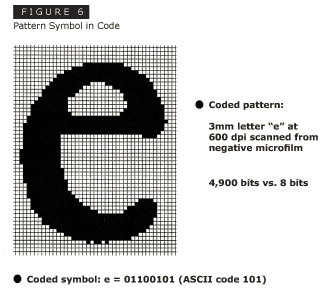
Dynamic range refers to the number of possible colors or shades of gray that can be included in a particular image. Dynamic range is sometimes called "depth" and is commonly represented as bits per pixel. In bitonal scanning, the sampled image level for each pixel is rounded to 0 (black) or 1 (white). One bit of information is required to code the value of the pixel. In 8-bit gray scanning, the sampled image level for each pixel is rounded to one of 256 values, each representing successively lighter shades of gray. Eight bits of information are required to represent each pixel. In full-color scanning, the three hues of the color system are represented by one of 256 possible shades and encoded as a total of 24 bits (8 bits per hue). The two predominant color systems are Red/Green/Blue for monitor projection and Cyan/Magenta/Yellow for digital printing.
Pixel size is an important measure of the capability of a given piece of scanning hardware to represent the patterns of a surface completely. The"real resolution" of a scanner is the proportion of the surface that is detected. The"addressable resolution" of a scanner is number of pixels in a running inch of an array without optical correction. Greater real resolution depends upon the quality of the electrical and mechanical engineering of a given device. Scanner manufacturers sometimes use software solutions (synthetic resolution) to compensate for limited real resolution. It is important to be wary of scanner manufacturer claims and to undertake rigorous testing and benchmarking before committing to the purchase of scanning equipment.10
Tone reproduction refers to the degree to which an image conveys the luminance ranges of an original scene (or of an image to be reproduced in the case of digital imaging). According to Reilly and Frey, tone"is the single most important aspect of image quality." Tone reproduction is the matching, modifying, or enhancing of output tones relative to the tones of the original document. Because all of the varied components of an imaging system contribute to tone reproduction, it is often difficult to control.11
Resolution, dynamic range, real resolution, and tone reproduction combine to endow an image with quality. When defined and measured carefully, the terms can be used to describe the characteristics of an image, to compare quality characteristics of two or more collections of images, and to compare the digital image with its original source. The resolution and dynamic range values of a given image can also be combined to describe the size of an image in terms of the amount of data that is required to represent the image in digital form.
Describing digital objects. The description of an image or collection of images in terms of quality and quantity is but half the story of a digital image product. Equally important is the digital data that describe the digital object itself. In modern imaging systems, such descriptive data exist as a linkage of at least three components. The first are the technical data (often called the image header) that describe the format of the digital image and the ways in which the raw digital data are compressed to save storage space and transmission time.
The second component is data describing the characteristics of the digital object (which may consist of one or more digital images). Metadata is data about data and as such is fundamentally linked to the accessibility of an object. As mere bitmaps, digital images are stupid and cannot be found or understood without some level of metadata.
The third descriptive component is information that describes the relationships between or among digital objects. Structural indexes are a crucial component to any digital imaging system where the content is hierarchical in nature (such as archival collections, books, scrapbooks, classified photograph collections, and the like). It is a rare digital object whose accessibility cannot be enhanced through the use of structural indexes. Structural information may reside as separate data (e.g., an encoded finding aid) or be built into the metadata system itself (e.g., controlled subject headings in a bibliographic record).
In summary, at the heart of the digital world is communication, which cannot happen without a shared vocabulary and a shared system of symbols. Digital imaging is representation by numbers of the world we can sense (see, touch, hear, smell, and taste). Images as bitmaps are pictures without intelligence. All meaning embedded in the digital technology system derives from layer upon layer of numerical coding, most of which must be done by people rather than machines. In the end, then, digital imaging is more profoundly about us than about the tools we use.
Digital Imaging Process and Product
We shall now turn our attention to the digital imaging processes and products by examining two general models.
Imaging Process Model
At its most elementary, the conversion of a book, a manuscript, a photographic negative, or a reel of microfilm is straightforward and linear. Source objects appropriate for conversion are selected and prepared for scanning; conversion occurs via scanning technology that transforms reflected light signals to digital data; access to the digital data is through display of the stored digital data. This apparent simplicity masks great complexity at all phases of the process.
- Source: Archives and libraries are legion for the complexity and variety of the collections eligible for digital conversion. Sources vary in size, format, medium, and condition; they may be text based; they may contain illustrations that themselves may vary wildly in character. Sources may have significant color content.
Not all digital conversion takes place from the original source. Film intermediates play an increasingly large role in a digital imaging system. Intermediates range in type from 35 mm color slides and high-contrast microfilm to full-frame microfiche and large-format negatives. Michael Ester has underscored the importance of understanding the characteristics of film intermediates."The digital image will only be as good as its photographic source; if visual detail or subtlety is not in the photographic medium, neither will it appear in the digital image.12
- Conversion: The conversion of source materials is—in equal parts—people and machinery. Equipment configurations are complex and rapidly evolving in capability. They consist of hardware, software, firmware (chip-based software), and storage systems. Imaging systems vary in their engineering sophistication, the quality of their sensory devices, the character of the software that is brought to bear to streamline the process, and the speed with which the system can carry out the conversion of a given source or collection of sources. It is crucial to"test drive" equipment configurations before purchasing or leasing them. A visit to other libraries, archives, service bureaus, and other organizations that have similar operational systems is a good way to learn how conversion systems work.
The digital conversion process is intensely labor intensive. At present, the quality and accessibility of the digital product largely depends upon the skills and talents that people bring to bear on the process of inspection, scanning, indexing, and data-file management. With enough effort, these skills can be obtained and maintained in-house. Today, it is more feasible than in the past to contract with companies that specialize in high-quality image conversion services.
- Access: At some level of abstraction, a digital product exists only if it can be found and viewed. Access systems for digital products are at least as complex as the systems that support conversion. Platforms (PC, Unix, Mac) vary in their capabilities; the adequacy of a network architecture can make or break an access system. Similarly, display technology (screens and printers) are vital to the ultimate use of the digital product.
Display technology is one of the main weak links in the entire system. Conversion technology is capable of generating far more data than can be usefully displayed by most of today's computer monitors.
Figure 7 is a schematic illustrating the elements of the process model. It is important to recognize that the complexity of a digital imaging system is only in part related to the complexity of the individual components. The elements of the process interact with each other to add complexity.
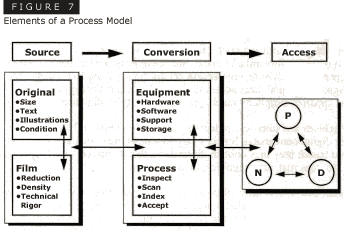
Imaging Product Model
The digital imaging process results in a product with its own characteristics that are distinct from the characteristics of the original sources. The biggest challenge in building an image product is to balance three issues: the characteristics of the source; the capabilities of the technologies of digital conversion; and the purposes or expected uses of the end product.
Figure 8 is a schematic defining the issues and suggesting a set of relationships that must be managed to produce an image product with sufficient value built in that it will be worth the cost and effort of ensuring its long-term preservation.
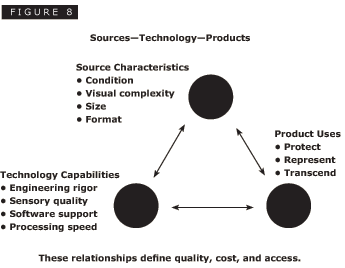
Of the three sets of issues (source, technology, uses) in the model, the concept of varying product uses is perhaps the least generally understood. A number of researchers in the field13 have begun to suggest that the quality of the end product can in some way be established through reference to one of three possible purposes that the product may serve for end users.
- Protect Originals. The most basic application of digital technologies in an archives or library is to create digital copies of sufficient quality that they can be used for ready reference in lieu of casual browsing through the original sources. Examples include image reference files of photographs, clippings, or vertical files that permit the identification of individual items requiring closer study. Preservation goals are met because the original documents can be protected by limiting access to them.
- Represent Originals. A digital system could be built that represents the information content of the original sources in such detail that the system can be used to fulfill most, if not all, of the research and learning potential of the original documents. High-resolution systems that strive for comprehensive and complete content and seek to obtain "full information capture" based on emerging standards and best practices, fit this definition. Systems of this intermediate level of quality open new avenues of research and use and have the capability to have a transformative effect on the service missions of those who create the products.
- Transcend Originals. In a small number of applications, digital imaging holds the promise to generate a product that can be used for purposes that are impossible to achieve with the original sources. This category includes imaging that uses special lighting to draw out details obscured by aging, use, and environmental damage; imaging that makes use of specialized photographic intermediates; or imaging of such high resolution that the study of artifactual characteristics is possible.
Each of these applications places separate, but increasingly rigorous demands on digital technologies. In each case, the use of an intermediate film or paper copy to facilitate the scanning process may be necessary or advisable. Finally, the disposition of original sources (including undertaking preservation treatments before or after conversion) is a separate matter. Ultimately, the purpose of the digital product is driven by access goals, while preservation of original source documents should be determined by the preservation needs of the original sources.
Food for Thought
This leaflet has already suggested a number of issues with which librarians and archivists must wrestle if their digital initiatives will have lasting value. Here are five questions that transcend the specifics of digital imaging technology.
- Technology. Is digital imaging the tail or the dog?
Those who market digital imaging technology prefer to use the term"solution" to describe the value of the their products. This term implies that the customer defines the problem and buys a technology solution. Digital technologies are a set of tools that offer many choices and few solutions. It may be more appropriate to distinguish between imaging projects that experiment with the capabilities of the technology (and result in institutional learning) from those that transform the very nature of our information management strategies.
- Control. Is it a four letter word?
Fundamental digital technology is stable. The digital imaging market place, however, is large, complex, and in a constant state of flux. Libraries and archives hold a small share of this market place. It is imperative that we seek to identify which elements of digital technology we can control, where our expertise is one of many important influences, and when we must accept the processes and products of the world in which we live.14
- Selection. Are our digital collections useful and usable?
Choice is at the heart of digital technology applications; the choice of technology is just the beginning. The choice of content is equally important. Unlike traditional library and archives collection development strategies that result in one decision to acquire and a separate decision to preserve many years later, selection in the digital world is an ongoing process of assessment and evaluation. Few digital collections will warrant the costs involved in maintaining access over time without factoring in the value and the character of ongoing use.15
- Quality. Are you willing to pay for it and will our readers?
In the past five years, librarians and archivists have made significant progress in defining their expectations for the quality of digital image products built from a variety of source materials. Quality is value that we add to our digital image products. Although important issues of quality measurement remain, the barriers to achieving quality do not appear to reside in the technology itself. Rather, the cost of creating and maintaining digital objects remains high; uncertainties persist about whether the overall costs of creating a product are declining.
- Preservation. Is any digital program not about preservation?
Costs are high; so is the risk of loss. Preservation in the digital world is knowing how to adapt preservation concepts to manage risk in the midst of rapid technological change. Digital imaging technology is more than another reformatting option. Imaging involves transforming the very concept of format, rather than creating an accurate picture of a book, document, photograph, or map on a different medium. Just as the invention of the vacuum tube created an entirely new form of mass communication—radio—instead of simply making point-to-point messaging possible without wires, digital imaging technologies create an entirely new form of information.
Written by Paul Conway
Attribution-NonCommercial-NoDerivs
CC BY-NC-ND
